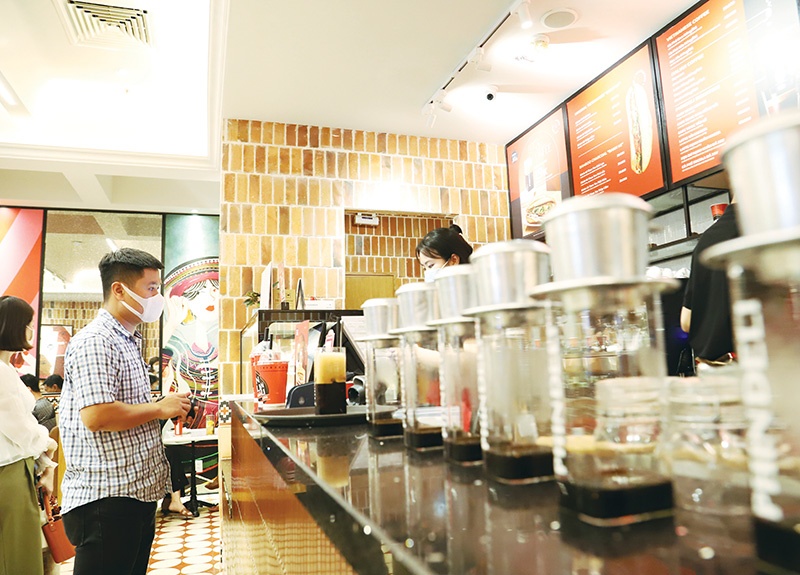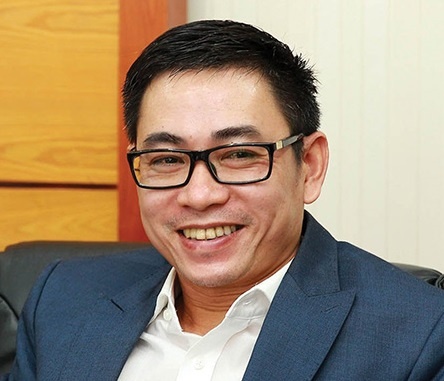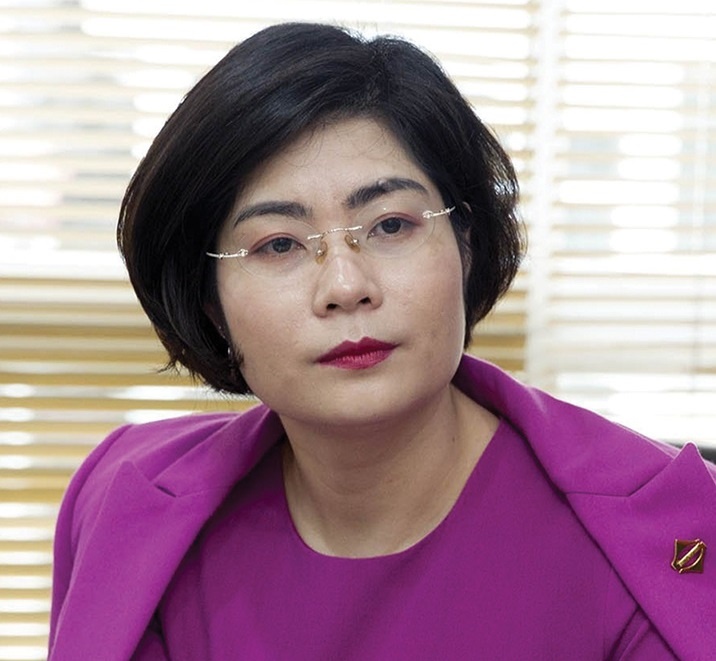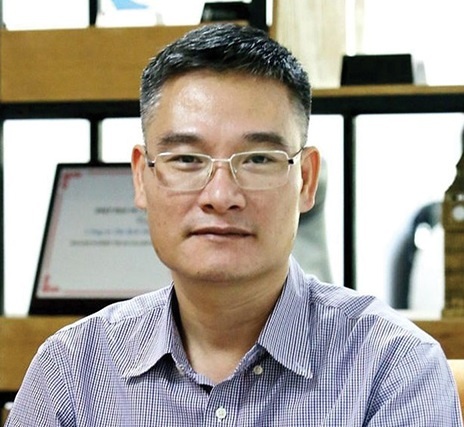Towns and cities shape up for big tourist return
 |
| After months of necessary abstinence, locals are flocking into cafes and restaurants. Photo: Le Toan |
“There are positive signs to open tourism,” the head of the secretariat of the Vietnam Tourism Advisory Board (TAB) Hoang Nhan Chinh said last week at an online exchange themed on a safe and effective schedule for reopening tourism, organised by Vietnam Investment Review.
The top factor agreed on current is that COVID-19 infection numbers in hotspots such as Ho Chi Minh City, Binh Duong, Dong Nai, and Hanoi have dropped significantly in recent weeks, while the rate of vaccination in these localities have increased rapidly.
According to the Ministry of Health, as of last week around 40 per cent of Vietnam’s population has been vaccinated with the first vaccine and over 16 per cent has received both shots. People in some major tourist centres such as Hanoi, Ho Chi Minh City, Quang Ninh, Danang, and Khanh Hoa have been a focus in getting both shots administered in order to reopen activities and facilities as soon and as safely as possible.
Along with the resumption of domestic flights, the first international flights to welcome international passengers with vaccine passports are also allowed to pilot in Quang Ninh and Phu Quoc Island, expected next month.
Last week, Hanoi began to allow restaurants and eateries to resume operations at 50 per cent capacity. Particularly in the tourism sector, hotels and accommodation business establishments that fully meet the requirements of pandemic prevention and control are allowed to operate at no more than 50 per cent capacity.
“The tourism industry is still waiting for specific instructions from ministries and sectors for reopening,” Chinh said.
Chinh suggested that Vietnam could refer to the Phuket sandbox model of Thailand, the Safe Travel Lane of Singapore, or the models of opening tourism of EU countries, and based on the key principle of safety for tourists and destinations.
For domestic tourism, the industry is looking to create favourable conditions for people living in green areas and already holding a COVID-19 green card to travel to other green areas without having to undergo isolation.
For international tourism, Vietnam will need to develop a safe process for welcoming and serving guests, quickly opening tourism to markets that have controlled the pandemic. “If the low infection rate is maintained, Vietnam’s tourism is likely to return to normal by 2024 thanks to domestic tourism, followed by international tourism,” he added.
Autumn has been deemed a favourable time to reopen tourism activities because the number of tourists travelling at this time is not too large, suitable for destinations to test operations and prepare for peak travel at the end of 2021 and into Lunar New Year.
Some tourism businesses, although unable to deeply reduce prices due additional testing costs and equipment for pandemic prevention, are committed to providing more utilities and service incentives to attract customers.
In Quang Ninh, Sun Group’s tourist attractions such as Yoko Onsen Quang Hanh opened to visitors in the province from October 1, while the Queen cable car is expected to reopen from the beginning of next month.
“We are also ready to welcome guests from outside the province as soon as Quang Ninh province and management agencies allow it,” said a representative of Sun Group.
Travel agencies are also not slow in the race to reopen. “This year we have maintained connections with customers and offered future tours that are flexible in terms of departure time. As long as the locality allows, the company can provide the service right away,” shared Nguyen Van Tai, general director of Vietsense Travel.
Tourism is a spearhead economic sector that, in the past, has directly contributed nearly 10 per cent of GDP. Now, only 5 per cent of businesses in the industry are still operating.
| Nguyen Van Tai - General director, Vietsense Travel
In order to effectively live with the pandemic, the tourism industry needs to clearly define safety criteria for organisation and conditions for safety in terms of service. Enterprises must wait for information from industry management, and be knowledgeable about destinations considered green and policies that localities are applying to tourists and tourism businesses. Vietsense Travel streamlines the apparatus to operate efficiently and optimise operating costs, as well as apply technology and digital transformation into operations and business transaction methods. Previously, the company only applied technology to online marketing, but now it has been applied to online sales channels. The operating of the organisation can also be set up smoothly through integrated software systems. We are currently implementing an employer-employee strategy. Previously, only leaders worked on strategy but now due to the reduction of personnel, the leadership department will directly perform operations such as sales and administration, which previously was carried out by a dedicated team. Regarding customer repositioning, the company aims at customers with high-paying capacity, using high-class services instead of cheap mass tour packages for large quantities as before. In the past, the number of customers and sales was the measure of efficiency. Currently, profit and customer value are the main measures as businesses are focusing on profit margins instead of sales revenues. | |
| Tran Nguyen - Head of Sales, Sun World
When reopening, we need to reposition the tourism industry in several directions. The safety factor is a prerequisite. Second, we must focus on the domestic tourism market because it has plenty of room to exploit. Domestic tourists spend quite a bit in the country, but about 10 million tourists travelling abroad each year in the past have a large amount of spending. It is expected that in the first months of 2022, the number of domestic tourists travelling abroad will be small. So this is an opportunity for professionals to reposition to attract outbound visitors. Third, digital transformation is an inevitable trend that began before the pandemic but has been accelerated since. Next, upgrading products need investment and enterprises should pay more attention to the experience, focusing on beautiful natural scenery. Destinations need new and emotional products to improve quality and provide customers with worthy services. At Sun Group’s properties in Danang, Lao Cai, and Phu Quoc, for example, every year there is at least one new project or product to attract visitors. For the international market, it is also necessary to reorient the flow of customers to build products and services that are suitable for needs and tastes. In particular, it is necessary to abandon the theory that Vietnam is a cheap destination. Let’s orient Vietnam as a friendly tourist destination with quality experiences for tourists. When repositioning the tourism industry, we also need to enhance experience for visitors by linking aviation properly with tourism and hotels. | |
| Nguyen Cong Hoan - General director, Flamingo Redtours
The pandemic has helped us have an accurate view of the limitations and strengths of the tourism industry and each business in particular, in order to make the appropriate adjustments. We must diversify the source of visitors and develop both outbound and inbound models in which the domestic market is very important. Customer needs are increasingly diverse and highly differentiated, so tour products need to be diversified and personalised for each object. In addition, competitiveness cannot be general and there should be differences. The factor of quality and added value will be more important than the price only. We cannot expect the market to develop comprehensively as before, but a gradual recovery is needed. I suggest that if the nature of the translation is the same between localities, the same criteria should be applied and no control gate is applied between those localities. Furthermore, domestic regulatory agencies need to exchange and cooperate with international organisations to ensure recognition of COVID-19 green cards between countries. Currently, children under 18 years of age have not yet been vaccinated against COVID-19, so it is necessary to have a mechanism and solution for this in terms of family travel. People who receive two injections still have to regularly test for COVID-19, and there may need to be measures to omit or reduce the frequency in order to avoid incurring costs and create comfort for visitors. |
What the stars mean:
★ Poor ★ ★ Promising ★★★ Good ★★★★ Very good ★★★★★ Exceptional
Related Contents
Latest News
More News
- The destinations powering Vietnam’s festive season travel demand (December 04, 2025 | 18:33)
- Vietnam named among the world’s most exciting winter destinations (December 04, 2025 | 15:10)
- Phu Tho emerges as northern Vietnam’s new tourism hub (December 01, 2025 | 17:00)
- Vietjet completes Airbus A320/A321 updates ahead of deadline (December 01, 2025 | 09:49)
- Vietjet resumes Con Dao flights from early December (November 28, 2025 | 15:24)
- Free tickets, Lunar New Year promotions on offer at Vietjet Mega Livestream (November 26, 2025 | 15:32)
- Scandinavian Airlines and Vietnam Airlines broaden agreement with new routes (November 25, 2025 | 17:04)
- Halong Cruise Port welcomes over 3,100 international visitors (November 12, 2025 | 18:06)
- Vietnam.travel climbs to second place in Southeast Asia website rankings (November 12, 2025 | 18:01)
- Cat Ba named among Southeast Asia’s top island adventures (November 11, 2025 | 18:09)




 Tag:
Tag:





















 Mobile Version
Mobile Version